Effects of Alternating Fresh and Saline Water Irrigation on Soil Salinity and Chlorophyll Fluorescence of Summer Maize
Abstract
1. Introduction
2. Materials and Methods
2.1. Experimental Site
2.2. Experimental Design
2.3. Data Collection and Analysis
2.3.1. Soil Samples
2.3.2. Plant Height and Leaf Area
2.3.3. Chlorophyll Fluorescence Parameters
2.3.4. Water Use Efficiency and Irrigation Water Use Efficiency
2.4. Statistical Analysis
3. Results
3.1. Dynamics of Soil Salinity (EC1:5)
3.2. Plant Height and Leaf Area
3.3. Maximal Quantum Yield (Fv/Fm) and Effective Quantum Yield of Photochemical Energy Conversion (ΦPSII)
3.4. Photochemical Quenching (qP) and Non-Photochemical Quenching (NPQ)
3.5. Yield and Its Components
3.6. ET, WUE and IWUE
4. Discussion
5. Conclusions
Author Contributions
Funding
Acknowledgments
Conflicts of Interest
References
- Sun, S.; Zhang, C.; Li, X.; Zhou, T.; Wang, Y.; Wu, P.; Cai, H. Sensitivity of crop water productivity to the variation of agricultural and climatic factors: A study of Hetao irrigation district, China. J. Clean Prod. 2017, 142, 2562–2569. [Google Scholar] [CrossRef]
- Gu, Z.; Qi, Z.M.; Burghate, R.; Yuan, S.Q.; Jiao, X.Y.; Xu, J.Z. Irrigation scheduling approaches and applications: A review. J. Irrig. Drain. Eng. ASCE 2020, 146, 04020007. [Google Scholar] [CrossRef]
- Khepar, S.D.; Yadav, A.K.; Sondhi, S.K.; Sherring, A. Modelling surplus canal water releases for artificial recharge of groundwater through surface drainage systems. Irrig. Sci. 2000, 19, 95–100. [Google Scholar]
- De Graaf, I.E.M.; Gleeson, T.; Beek, L.P.H.R.V.; Sutanudjaja, E.H.; Bierkens, M.F.P. Environmental flow limits to global groundwater pumping. Nature 2019, 574, 90–94. [Google Scholar]
- Mao, W.; Yang, J.Z.; Zhu, Y.; Ye, M.; Wu, J.W. Loosely coupled SaltMod for simulating groundwater and salt dynamics under well-canal conjunctive irrigation in semi-arid areas. Agric. Water Manag. 2017, 192, 209–220. [Google Scholar]
- Madramootoo, C.A. Sustainable groundwater use in agriculture. Irrig. Drain. 2012, 61, 26–33. [Google Scholar]
- Arslan, H. Estimation of spatial distrubition of groundwater level and risky areas of seawater intrusion on the coastal region in aramba Plain, Turkey, using different interpolation methods. Environ. Monit. Assess. 2014, 186, 5123–5134. [Google Scholar] [PubMed]
- Jasechko, S.; Perrone, D.; Seybold, H.; Fan, Y.; Kirchner, J.W. Groundwater level observations in 250,000 coastal US wells reveal scope of potential seawater intrusion. Nat. Commun. 2020, 11, 3229. [Google Scholar]
- Liu, Q.; Li, F.D.; Zhang, Q.Y.; Li, J.; Zhang, Y.; Tu, C.; Ouyang, Z. Impact of water diversion on the hydrogeochemical characterization of surface water and groundwater in the Yellow River Delta. Appl. Geochem. 2014, 48, 83–92. [Google Scholar] [CrossRef]
- Al-Muaini, A.; Green, S.; Dakheel, A.; Abdullah, A.; Abou, D.; Wasel, A. Water requirements for irrigation with saline groundwater of three date-palm cultivars with different salt-tolerances in the hyper-arid United Arab Emirates. Agric. Water Manag. 2019, 222, 123–131. [Google Scholar] [CrossRef]
- Kang, Y.; Chen, M.; Wan, S. Effects of drip irrigation with saline water on waxy maize (Zea mays L. var. ceratina Kulesh) in North China Plain. Agric. Water Manag. 2010, 97, 1303–1309. [Google Scholar] [CrossRef]
- Feng, G.; Zhang, Z.; Wan, C.; Lu, P.; Bakour, A. Effects of saline water irrigation on soil salinity and yield of summer maize (Zea mays L.) in subsurface drainage system. Agric. Water Manag. 2017, 193, 205–213. [Google Scholar] [CrossRef]
- Huang, C.H.; Xue, X.; Wang, T.; Mascellis, R.D.; Mele, G.; You, Q.G.; Peng, F. Effects of saline water irrigation on soil properties in northwest china. Environ. Earth Sci. 2011, 63, 701–708. [Google Scholar] [CrossRef]
- Mandal, U.K.; Bhardwaj, A.K.; Warrington, D.N.; Goldstein, D.; Tai, A.B.; Levy, G.J. Changes in soil hydraulic conductivity, runoff, and soil loss due to irrigation with different types of saline–sodic water. Geoderma 2008, 144, 509–516. [Google Scholar]
- Min, W.; Guo, H.J.; Zhou, G.W.; Zhang, W.; Ma, L.J.; Ye, J.; Hou, Z.N. Root distribution and growth of cotton as affected by drip irrigation with saline water. Field Crop Res. 2014, 69, 1–10. [Google Scholar]
- Kan, I.; Rapaport-Rom, M. Regional blending of fresh and saline irrigation water: Is it efficient? Water Resour. Res. 2012, 48, 1–14. [Google Scholar] [CrossRef]
- Li, J.S.; Gao, Y.M.; Zhang, X.Y.; Tian, P.; Li, J.; Tian, Y.Q. Comprehensive comparison of different saline water irrigation strategies for tomato production: Soil properties, plant growth, fruit yield and fruit quality. Agric. Water Manag. 2019, 213, 521–533. [Google Scholar] [CrossRef]
- Abdel, G.G.; Arslan, A.; Gaihbe, A.; Kadouri, F.; Ragab, R. The effects of saline irrigation water management and salt tolerant tomato varieties on sustainable production of tomato in Syria (1999–2002). Agric. Water Manag. 2005, 78, 39–53. [Google Scholar]
- Malash, N.; Flowers, T.J.; Ragab, R. Effect of irrigation systems and water management practices using saline and non-saline water on tomato production. Agric. Water Manag. 2005, 78, 25–38. [Google Scholar] [CrossRef]
- Minhas, P.S. Saline water management for irrigation in India. Agric. Water Manag. 1996, 30, 1–24. [Google Scholar] [CrossRef]
- Chomba, E.; Westcott, C.M.; Westcott, J.E.; Mpabalwani, E.M.; Krebs, N.F.; Patinkin, Z.W.; Palacios, N.; Hambidge, K.M. Zinc absorption from biofortified maize meets the requirements of young rural zambian children. J. Nutr. 2015, 145, 514–519. [Google Scholar] [CrossRef] [PubMed]
- Isla, R.; Aragues, R. Yield and plant ion concentrations in maize (Zea mays L.) subject to diurnal and nocturnal saline sprinkler irrigations. Field Crop Res. 2010, 116, 175–183. [Google Scholar] [CrossRef]
- Chen, L.J.; Qi, F. Soil water and salt distribution under furrow irrigation of saline water with plastic mulch on ridge. J. Arid Land. 2013, 5, 60–70. [Google Scholar] [CrossRef][Green Version]
- Li, J.; Chen, J.; Qu, Z.; Wang, S.; He, P.; Zhang, N. Effects of Alternating Irrigation with Fresh and Saline Water on the Soil Salt, Soil Nutrients, and Yield of Tomatoes. Water 2019, 11, 1693. [Google Scholar] [CrossRef]
- Okhovatianardakani, A.R.; Mehrabanian, M.; Dehghani, F.; Akbarzadeh, A. Salt tolerance evaluation and relative comparison in cuttings of different pomegranate cultivars. Plant Soil Environ. 2010, 56, 176–185. [Google Scholar] [CrossRef]
- He, K.; Yang, Y.; Yang, Y.; Chen, S.; Hu, Q.; Liu, X.; Gao, F. HYDRUS Simulation of Sustainable Brackish Water Irrigation in a Winter Wheat-Summer Maize Rotation System in the North China Plain. Water 2017, 9, 536. [Google Scholar] [CrossRef]
- Li, J.; Chen, J.; Jin, J.; Wang, S.; Du, B. Effects of Irrigation Water Salinity on Maize (Zea may L.) Emergence, Growth, Yield, Quality, and Soil Salt. Water 2019, 11, 2095. [Google Scholar] [CrossRef]
- Magán, J.J.; Gallardo, M.; Thompson, R.B.; Lorenzo, P. Effects of salinity on fruit yield and quality of tomato grown in soil-less culture in greenhouses in mediterranean climatic conditions. Agric. Water Manag. 2008, 95, 1041–1055. [Google Scholar] [CrossRef]
- Pang, H.C.; Li, Y.Y.; Yang, J.S.; Liang, Y.S.; Yang, J.S. Effect of brackish water irrigation and straw mulching on soil salinity and crop yields under monsoonal climatic conditions. Agric. Water Manag. 2010, 97, 1971–1977. [Google Scholar] [CrossRef]
- Huang, M.; Zhang, Z.; Sheng, Z.; Zhu, C.; Zhai, Y.; Lu, P. Effect on Soil Properties and Maize Growth by Alternate Irrigation with Brackish Water. Trans. ASABE 2019, 62, 485–493. [Google Scholar] [CrossRef]
- Zhu, C.L.; Huang, M.Y.; Zhai, Y.M.; Zhang, Z.Y.; Zheng, J.Y.; Liu, Z.X. Response of gas exchange and chlorophyll fluorescence of maize to alternate irrigation with fresh- and brackish water. Acta Agric. Scand. Sect. B Plant Soil Sci. 2017, 67, 474–484. [Google Scholar] [CrossRef]
- Abbasi, G.H.; Akhtar, J.; Ahmad, R.; Jamil, M.; Anwar-ul-Haq, M.; Ali. Potassium application mitigates salt stress differentially at different growth stages in tolerant and sensitive maize hybrids. Plant Growth Regul. 2015, 76, 111–125. [Google Scholar] [CrossRef]
- Oladipo, I.O.; Yu, X.S.; Liao, Y.C. Effect of salinity water irrigation on maize growth in northwest region. J. Chem. Phermaceutical Res. 2014, 6, 300–305. [Google Scholar]
- Ashraf, M. Some important physiological selection criteria for salt tolerance in plants. Flora 2004, 199, 361–376. [Google Scholar] [CrossRef]
- Jia, M.; Zhou, C.; Cheng, T.; Tian, Y.; Zhu, Y.; Cao, W.; Yao, X. Inversion of chlorophyll fluorescence parameters on vegetation indices at leaf scale. In Proceedings of the 2016 IEEE International Geoscience and Remote Sensing Symposium (IGARSS), Beijing, China, 10–15 July 2016; pp. 4359–4362. [Google Scholar]
- Tan, C.S.; Drury, C.F.; Gaynor, J.D.; Wesenbeeck, I.V.; Soultani, M. Effect of water-table management and nitrogen supply on yield, plant growth and water use of corn in undisturbed soil columns. Can. J. Plant Sci. 1996, 76, 229–235. [Google Scholar] [CrossRef]
- Hassan, M.; Christopher, T.; Ghizan, S.; Ahmad, S.; Mohammad, E.A.; Behnam, K. Non-destructive estimation of maize leaf area, fresh weight, and dry weight using leaf length and leaf width. Commun. Biometry Crop Sci. 2010, 5, 19–26. [Google Scholar]
- Sinsawat, V.; Leipner, J.; Stamp, P.; Fracheboud, Y. Effect of heat stress on the photosynthetic apparatus in maize (zea mays, l.) grown at control or high temperature. Environ. Exp. Bot. 2004, 52, 123–129. [Google Scholar] [CrossRef]
- Zhang, H.; Wang, X.; You, M.; Liu, C. Water-yield relations and water-use efficiency of winter wheat in the North China Plain. Irrig. Sci. 1999, 19, 37–45. [Google Scholar]
- Rose, D.A.; Konukcu, F.; Gowing, J.W. Effect of water table depth on evaporation and salt accumulation from saline groundwater. Soil Res. 2005, 43, 565–573. [Google Scholar] [CrossRef]
- Wang, Q.M.; Huo, Z.L.; Zhang, L.D.; Wang, J.H.; Zhao, Y. Impact of saline water irrigation on water use efficiency and soil salt accumulation for spring maize in arid regions of China. Agric. Water Manag. 2016, 163, 125–138. [Google Scholar] [CrossRef]
- Sun, Z.Q.; Dong, X.Q.; Wang, X.J.; Zheng, D.F.; Dong, L.; Liu, Z.H. Effect of saline drip irrigation to soil water and salt distribution and cotton yield in northern Shandong plain. Agric. Res. Arid Areas. 2014, 32, 12–18. [Google Scholar]
- Jin, X.J.; Fan, J.L.; Xu, B.; Li, B.W.; Xu, X.W. Respond of Plant Growth and Soil Water-Salt to Different Irrigation Amounts in Little Thickness Aeration Zone in the Hinterland of Taklimakan Desert. Adv. Mater. Res. 2013, 726–731, 3872–3876. [Google Scholar] [CrossRef]
- Abebe, T.; Guenzi, A.C.; Martin, B.; Cushman, J.C. Tolerance of mannitol-accumulating transgenic wheat to water stress and salinity. Plant Physiol. 2003, 131, 1748–1755. [Google Scholar] [CrossRef] [PubMed]
- Qu, C.; Liu, C.; Gong, X.; Li, C.; Hong, M.; Wang, L.; Hong, F. Impairment of maize seedling photosynthesis caused by a combination of potassium deficiency and salt stress. Environ. Exp. Bot. 2012, 75, 134–141. [Google Scholar] [CrossRef]
- Baker, N.R.; Rosenqvist, E. Applications of chlorophyll fluorescence can improve crop production strategies: An examination of future possibilities. J. Exp. Bot. 2004, 55, 1607–1621. [Google Scholar] [CrossRef] [PubMed]
- Chaum, S.; Kirdmanee, C. Effect of salt stress on proline accumulation, photosynthetic ability and growth characters in two maize cultivars. Pak. J. Bot. 2009, 41, 87–98. [Google Scholar]
- Otegui, M.E.; Andrade, F.H.; Suero, E.E. Growth, water use, and kernel abortion of maize subjected to drought at silking. Field Crops Res. 1995, 40, 87–94. [Google Scholar] [CrossRef]
- Zarcoperello, E.; Gonzalezhernandez, V.A.; Lopezperalta, M.C.; Salinasmoreno, Y. Physiological markers for drought tolerance in maize (Zea mays L.). Agrociencia 2005, 39, 517–528. [Google Scholar]
- Oveysi, M.; Mirhadi, M.J.; Madani, H.; Nourmohammadi, G.; Zarghami, R.; Madani, A. The impact of source restriction on yield formation of corn (Zea mays L.) due to water deficiency. Plant Soil Environ. 2010, 56, 476–481. [Google Scholar] [CrossRef]
- Mi, N.; Cai, F.; Zhang, Y.S.; Ji, R.P.; Zhang, S.J.; Wang, Y. Differential responses of maize yield to drought at vegetative and reproductive stages. Plant Soil Environ. 2018, 64, 260–267. [Google Scholar]
- Zegada-Lizarazu, W.; Zatta, A.; Monti, A. Water uptake efficiency and above- and belowground biomass development of sweet sorghum and maize under different water regimes. Plant Soil 2012, 351, 47–60. [Google Scholar] [CrossRef]
- Zhangzhong, L.; Yang, P.; Zheng, W.; Wang, C.; Zhang, C.; Niu, M. Effects of Drip Irrigation Models on Chemical Clogging under Saline Water Use in Hetao District, China. Water 2018, 10, 345. [Google Scholar] [CrossRef]
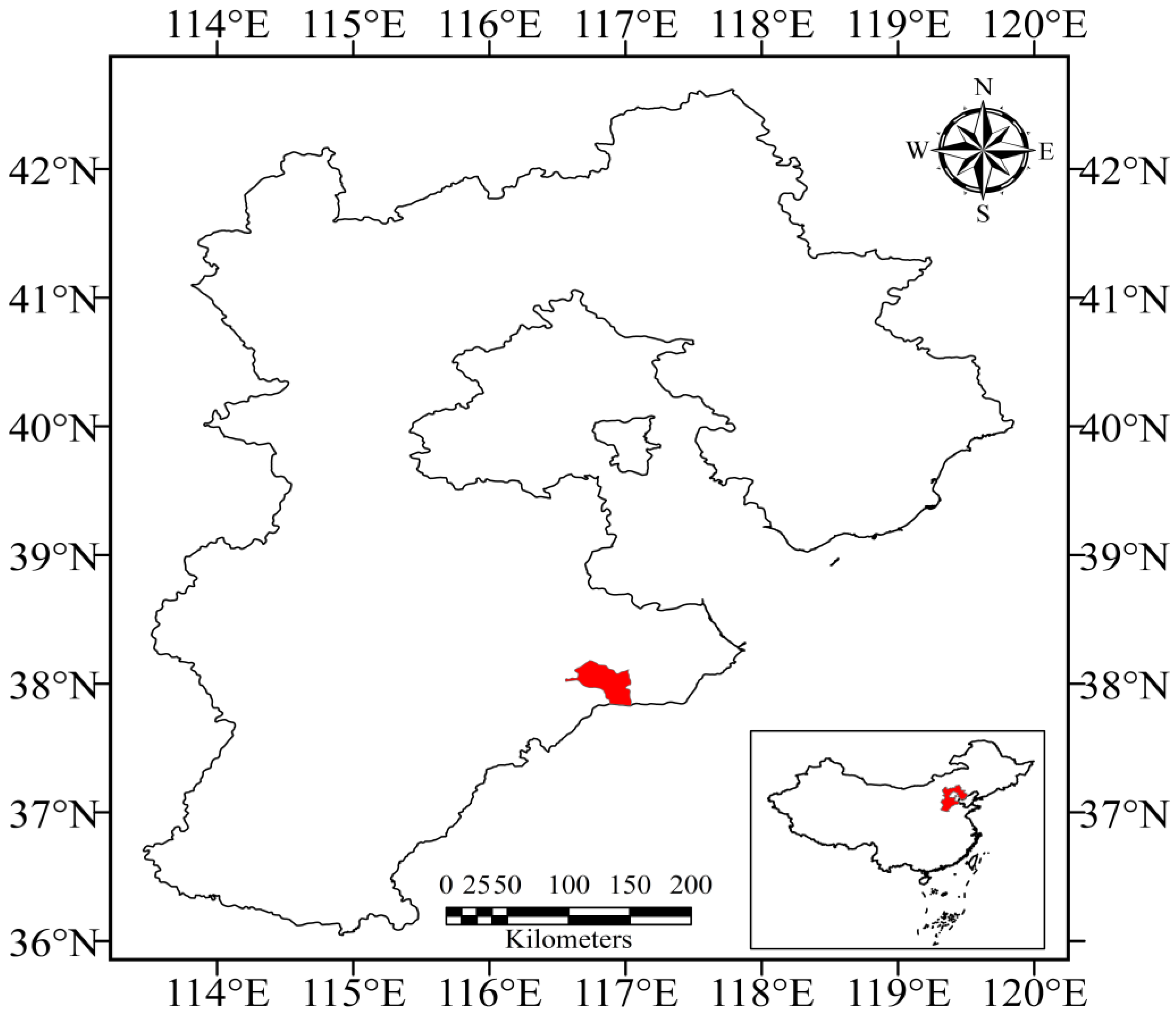
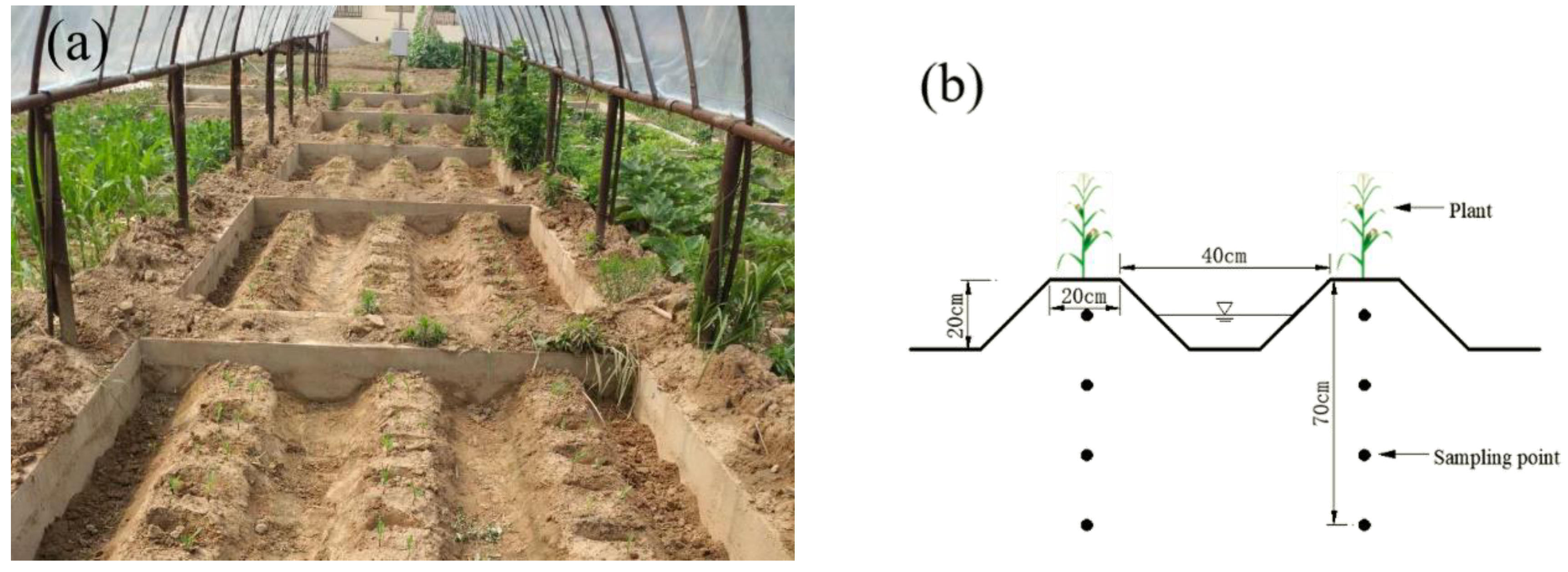

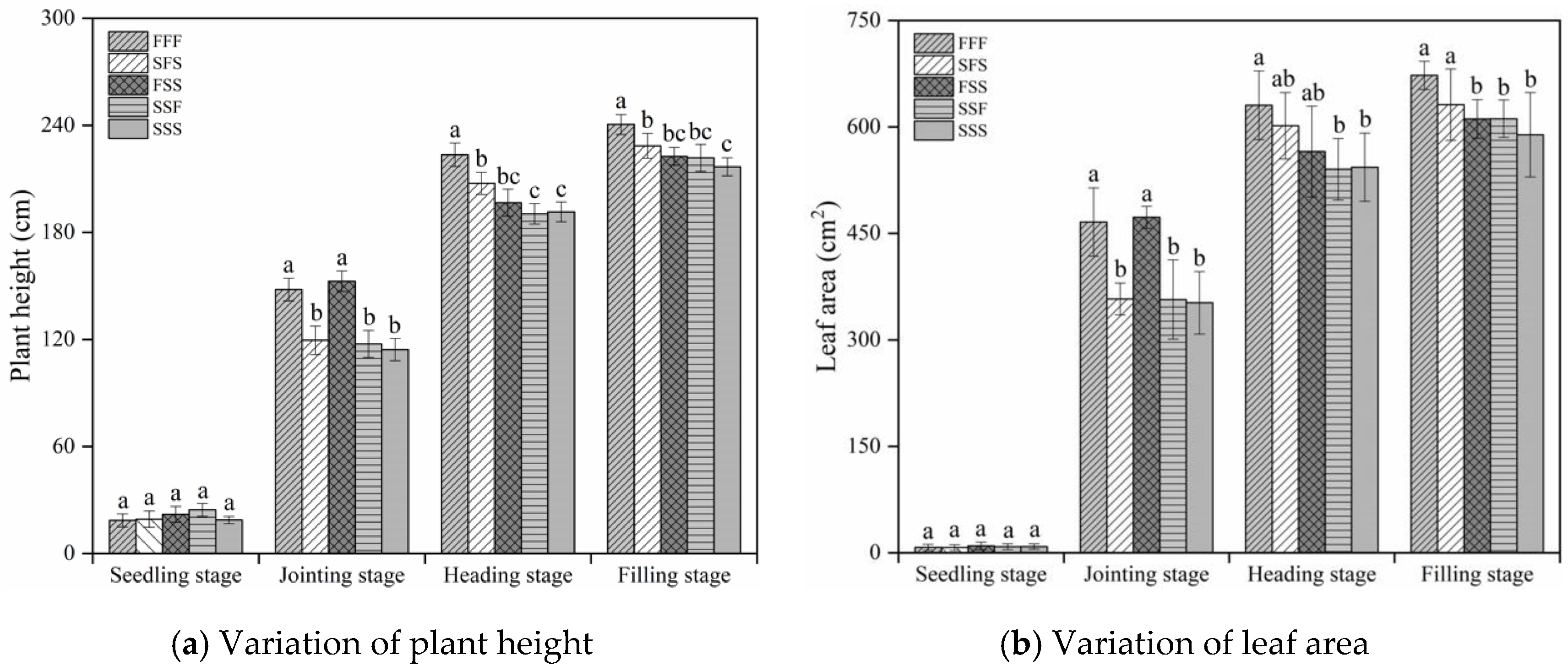
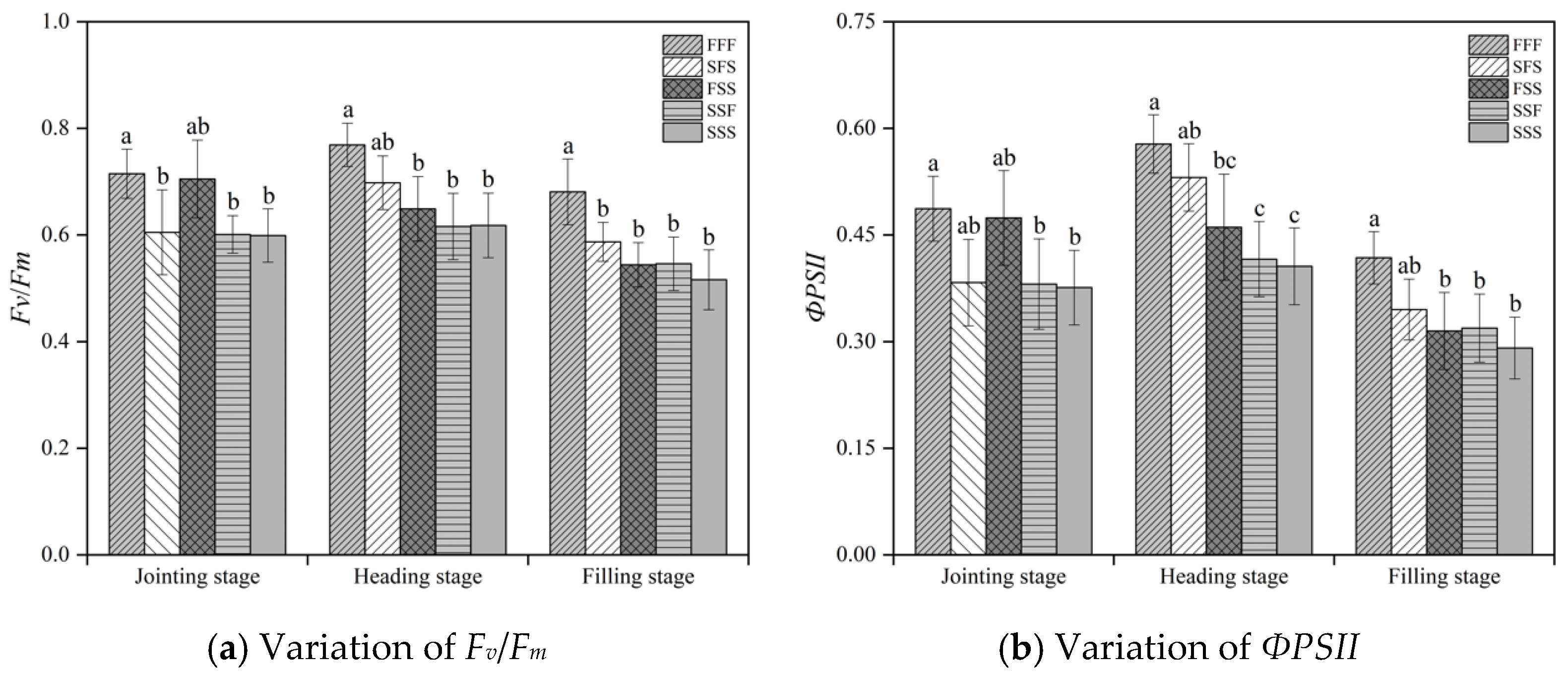
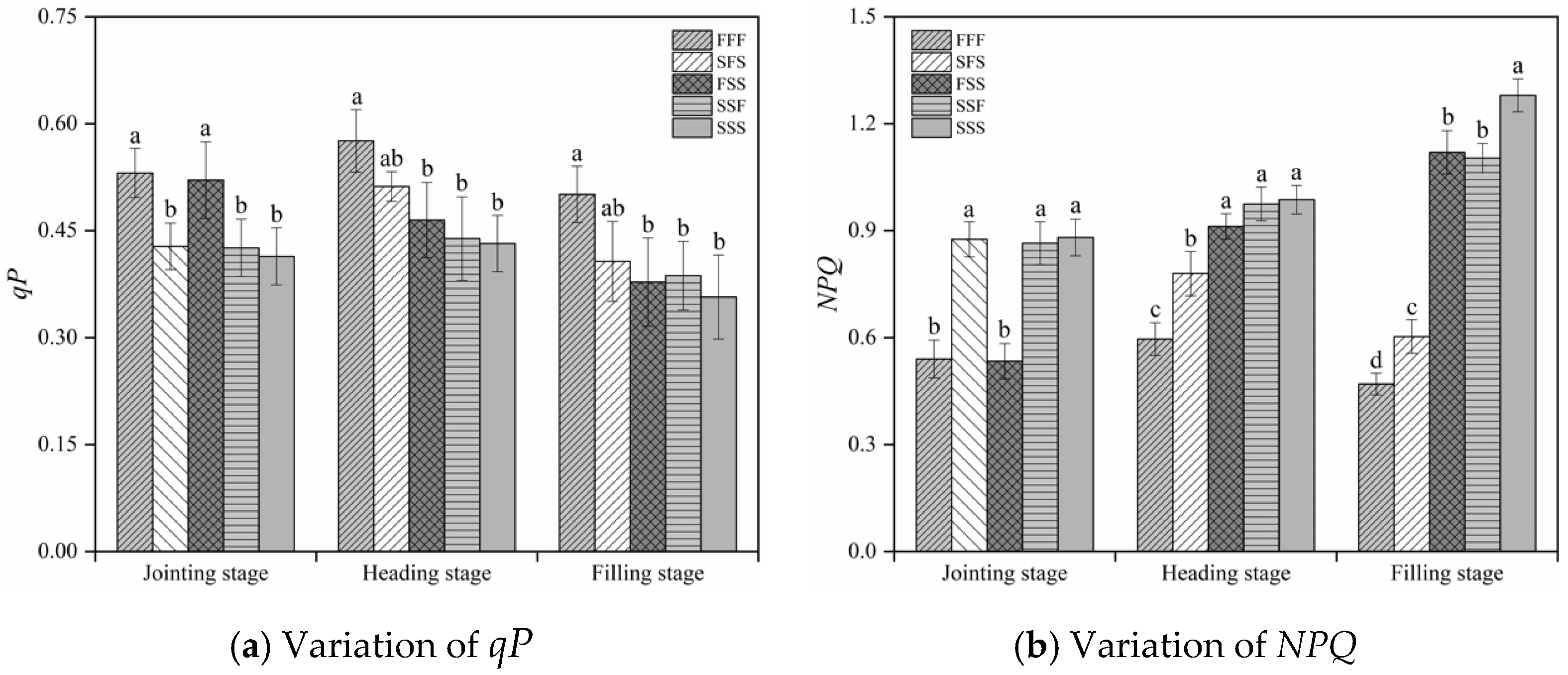

| Soil Layers (cm) | Soil Mechanical Composition (%) | Soil Texture | Soil Bulk Density (g cm−3) | Field Capacity (cm3 cm−3) | ||
|---|---|---|---|---|---|---|
| Clay (<0.002 mm) | Silt (0.002–0.02 mm) | Sand (0.02–2 mm) | ||||
| 0–10 | 7.60 | 58.30 | 34.09 | Silt loam | 1.33 | 32.57 |
| 10–20 | 9.01 | 62.26 | 28.73 | Silt loam | 1.47 | 34.41 |
| 20–40 | 10.61 | 66.07 | 23.31 | Silt loam | 1.53 | 36.21 |
| 40–60 | 12.82 | 67.25 | 19.94 | Silt loam | 1.56 | 37.68 |
| 60–80 | 15.30 | 68.06 | 16.65 | Silt loam | 1.58 | 36.45 |
| 80–100 | 16.56 | 66.01 | 17.43 | Silt loam | 1.53 | 35.13 |
| Treatments | Jointing Stage | Heading Stage | Filling Stage |
|---|---|---|---|
| FFF | Freshwater | Freshwater | Freshwater |
| SFS | Saline water | Freshwater | Saline water |
| FSS | Freshwater | Saline water | Saline water |
| SSF | Saline water | Saline water | Freshwater |
| SSS | Saline water | Saline water | Saline water |
| Treatment | Spike Number (104 ha−1) | Number of Kernels per Ear | 100-Kernel Weight (g) | Grain YIELD (t ha−1) |
|---|---|---|---|---|
| FFF | 4.55 a | 592 a | 46.87 a | 11.35 a |
| SFS | 3.94 b | 540 b | 44.57 a | 8.53 b |
| FSS | 3.79 b,c | 505 c | 44.66 a | 7.69 b,c |
| SSF | 3.79 b,c | 480 c,d | 45.56 a | 7.45 c |
| SSS | 3.64 c | 468 d | 41.08 b | 6.30 d |
Publisher’s Note: MDPI stays neutral with regard to jurisdictional claims in published maps and institutional affiliations. |
© 2020 by the authors. Licensee MDPI, Basel, Switzerland. This article is an open access article distributed under the terms and conditions of the Creative Commons Attribution (CC BY) license (http://creativecommons.org/licenses/by/4.0/).
Share and Cite
Sang, H.; Guo, W.; Gao, Y.; Jiao, X.; Pan, X. Effects of Alternating Fresh and Saline Water Irrigation on Soil Salinity and Chlorophyll Fluorescence of Summer Maize. Water 2020, 12, 3054. https://doi.org/10.3390/w12113054
Sang H, Guo W, Gao Y, Jiao X, Pan X. Effects of Alternating Fresh and Saline Water Irrigation on Soil Salinity and Chlorophyll Fluorescence of Summer Maize. Water. 2020; 12(11):3054. https://doi.org/10.3390/w12113054
Chicago/Turabian StyleSang, Honghui, Weihua Guo, Yun Gao, Xiyun Jiao, and Xiaobao Pan. 2020. "Effects of Alternating Fresh and Saline Water Irrigation on Soil Salinity and Chlorophyll Fluorescence of Summer Maize" Water 12, no. 11: 3054. https://doi.org/10.3390/w12113054
APA StyleSang, H., Guo, W., Gao, Y., Jiao, X., & Pan, X. (2020). Effects of Alternating Fresh and Saline Water Irrigation on Soil Salinity and Chlorophyll Fluorescence of Summer Maize. Water, 12(11), 3054. https://doi.org/10.3390/w12113054




